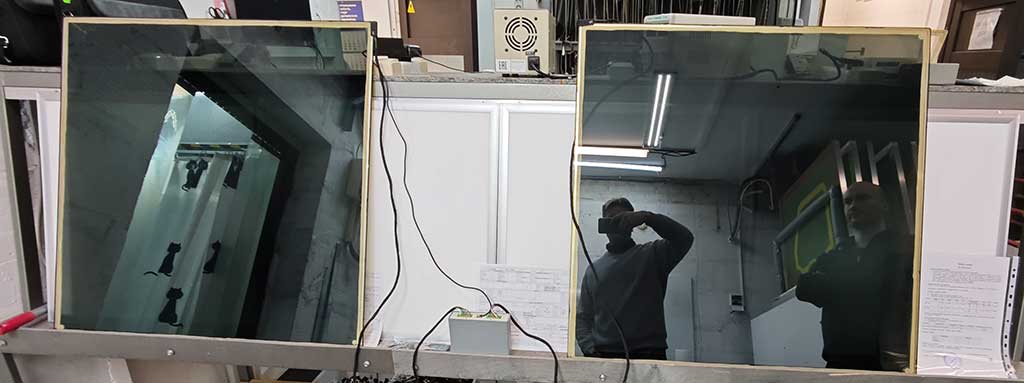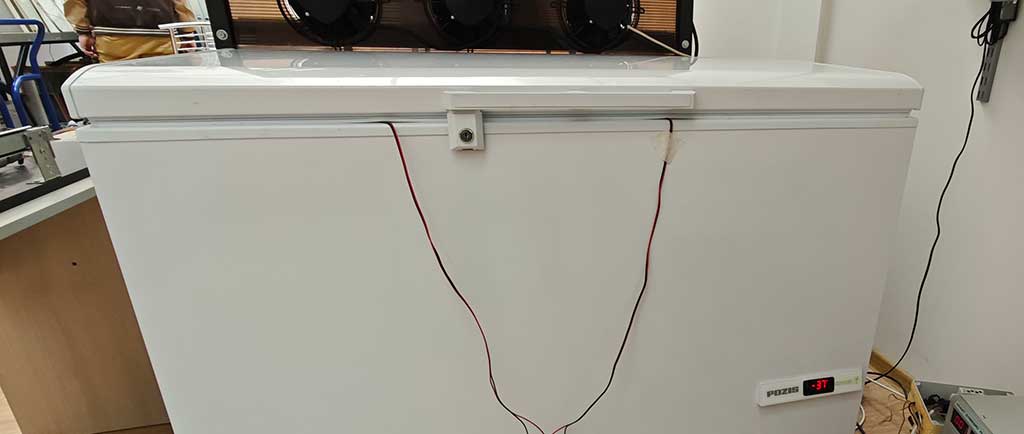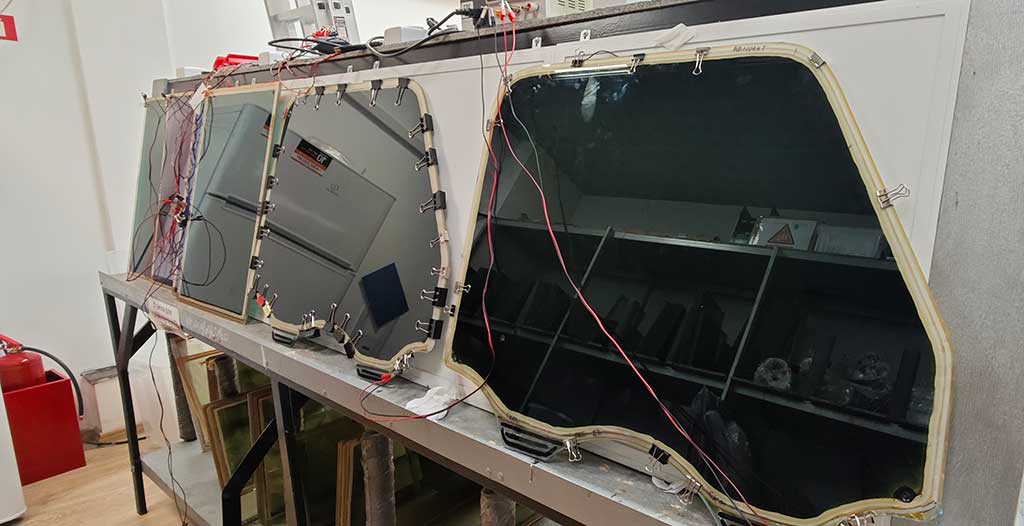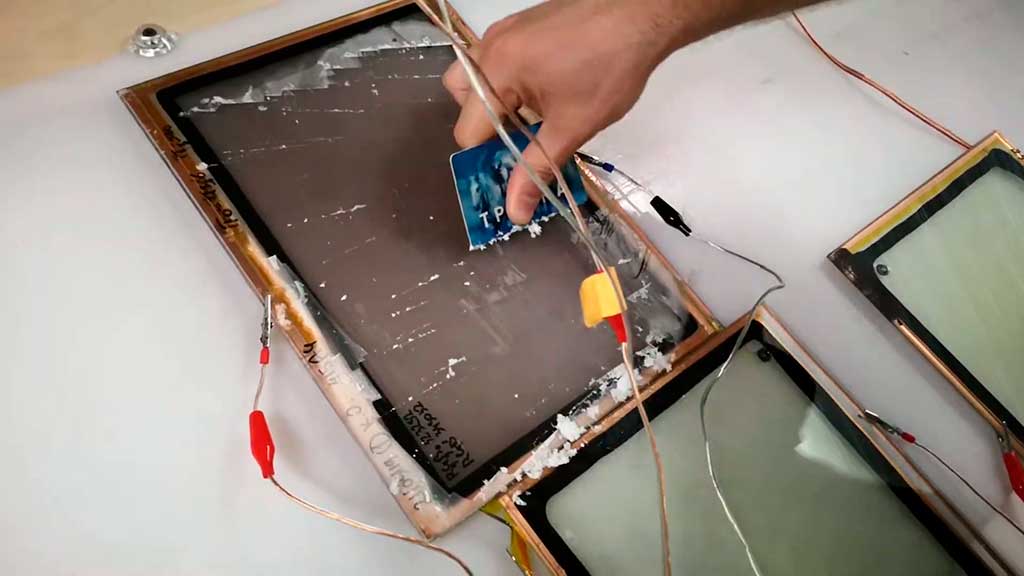We at Octoglass produce electrochromic tinting for cars. Despite the fact that electrochromism as a phenomenon has been known to mankind since the 16th century, products with electrochromic components have not become popular. The reason is distrust of technology, people doubt the reliability of such products. Therefore, before launching a product on the market, our team was faced with the question: how can we conduct development testing and make sure that in a month, quarter, year or later our client will not return to us with a complaint about our product?
Testing a product for stability during long-term operation is not a trivial task. Two strategies are used to solve this problem. The first is testing on the client. After minimal verification of the product and technology, production and distribution of products begins. Feedback is collected to eliminate defects, the product is gradually improved, finished, and becomes more stable. Advantages - low costs for the debugging process and capture a certain market share. The disadvantages include loss of customer loyalty and loss of business reputation in the event of deceived customer expectations, for example, in the case of mass defects in products and ignoring the company's warranty obligations. This method works well in the world of information technology, but has limited application in the markets of real goods. Afterall, few customers want to participate in testing expensive products, and even at their own expense. So you can quite easily destroy a young, developing sales market.
An alternative approach is to fully test products within the manufacturing company. With this approach, numerous and diverse tests are used, including product tests in terms of service life, the so-called aging tests. In this case, the company's costs for product development increase, it may lag behind competitors in the development of the customer base, lose time and resources in the eyes of investors, but at the same time not lose the trust of customers. In addition to delays and high costs, it is impossible to anticipate all possible product use cases. The client is inventive, and their terms of use for the product may кардинально differ dramatically from the developers ' ideas.
We at Octoglass have come to the decision that the second way is our conscious choice. It is associated with a fanatical passion for the work that we are engaged in, and the idealization of our developments, on which years have been spent. We abandoned the idea of using our clients as guinea pigs, and decided to offer them a full-fledged and long-lasting product, even if not immediately after receiving the first results, the first products.
For EC-glass testing standards bodies have already developed accelerated aging tests for testing electrochromic solutions. We are talking about the American standard ANSI E2141 and its European and Russian tracing papers in the form of ISO standards and such GOST standards as 32611, 56758, 56733. Within the framework of these standards, specialized installations are used that provide high humidity, elevated temperatures and a sufficient level of light radiation that is as close as possible to sunlight.

Electrochromic glass is placed in the installation, where it is cyclically colored and discolored. The emphasis in such tests is placed precisely on cyclic switching. The test is quite adequate, but it was created for the so-called relay electrochromic devices. The most prominent representative of such products is an electrochromic device, both hybrid and fully solid-state, based on thin films. Such devices are based on stacks of thin films deposited, as a rule, by the vacuum-magnetron method (in the international literature, this method of deposition is referred to as Physical Vapor Deposition or abbreviated PVD) and having thicknesses of tens and hundreds of nanometers.
In hybrid devices, two substrates, the anode and cathode, with thin films deposited, are colaminated with each other by means of a polymer electrolyte, and in a fully solid-state device, as a rule, all layers are deposited on one substrate, including the separating electrolytic layer. The interaction of electrochromic layers, and the staining or discoloration of the electrochromic component occurs during its electrochemical oxidation or reduction, is carried out by electron transfer through the layers of thin films. In such an interaction, there is no physical movement of molecules or atoms between the electrochromic layers.
Hybrid thin-film devices Octoglass are tested in accordance with the requirements of the standards. They cycle for a long time. According to the standards, an electrochromic device that has completed 50,000 complete cycles of staining and discoloration is considered to have passed the test, and in real operation, such devices will work for about 50 years. Well, then. Our hybrid electrochromic devices can withstand 70,000 cycles, but we do not test further, since even 70 thousand cycles take several months of continuous testing — electrochromic devices are quite slow in themselves.
But the Octoglass technology portfolio also includes a diffuse electrochromic solution, testing of which has a much higher priority due to the presence of a significantly more complex chemical structure and the presence of a full-fledged product release based on it. Moreover, it is on the diffuse system that automotive electrochromic glass, our main product, is produced. And the standard testing methods proposed by standardizers does not allow us to identify the weaknesses of the diffuse version.
Why? This is because electrochromism works somewhat differently in a diffuse system. In such a system, the electrochromic components are dissolved in the electrolyte and physically move to the anode and cathode sides of the device when a voltage is applied. And if cycling allows you to reliably check the quality of thin films, then there are no thin films in the diffuse system and there is nothing to spoil there. So what is a diffuse electrochromic device afraid of? What should I test for?

As a rule, diffuse electrochromic devices, including Octoglass solutions are most susceptible to the destructive effects of ultraviolet radiation, prolonged exposure to electric current, and temperature effects from both low and high temperatures. Let's try to understand all this variety of dangers in more detail.
Ultraviolet light is fundamentally dangerous for any type of smart glass, regardless of its design. The photon energy of the ultraviolet spectrum is sufficient to destroy not only organic molecules, but also inorganic structures. It is good that silicate glass used for the manufacture of electrochromic glass does not transmit the most intense spectra in the form of UV-C and UV-B. But UV-A can also damage the device during long-term operation, bombarding and pumping structures with energetic photons. This means that it is necessary to check not just light stability, but stability under the influence of ultraviolet radiation. Moreover, in the colored state, the electrochromic device absorbs more ultraviolet photons than in the transparent state. Which, in fact, is not surprising, because when tinting electrochromic glass, the visible light spectrum is most evenly absorbed to achieve the most neutral color of the resulting tinting, and the UV-A range is also partially captured along the way.
Another factor is that being energized for a long time means that the device is in a painted state. Electrochemistry in a diffuse device is quite complex, I will not frighten the reader with the numerous names of chemists of the past and present, whose names were called the processes that occur in an electrochromic device, but the reaction there is constantly going on. And as in any continuous process system, errors accumulate over time, in terms of an electrochromic device, the number of incorrect chemical bonds increases, and the degree of degradation increases. It is for this reason that such devices need to be relaxed, read discolored, after a certain period of continuous use. It is important not to exceed the degradation potential of a particular device, otherwise full recovery will not occur. As for temperature effects, the polymer electrolyte is essentially a sponge soaked in liquid. And from the influence of temperature, the liquid changes in size. Increases in volume at high temperatures and shrinks at low temperatures. This can lead, firstly, to damage to the device itself, the electrochromic glass, and secondly, to breaks in the polymer matrix, when the flexibility of the glass no longer allows you to compensate for the change in the volume of the electrolyte.
Combining all the critical factors affecting a diffuse electrochromic device in a single test is quite an interesting task and at the same time difficult to do. That's why we went the other way at Octoglass. We have developed tests that allow us not to spend years testing our devices, but to get reliable information about the reliability of our developments. The main test concerns exposure to ultraviolet radiation. Our employees have developed a universal test for diffuse electrochromic devices, which allows us to evaluate the operational durability of the device in real conditions. We calculated the doses of ultraviolet radiation that electrochromic glass receives during operation in the most unfavorable conditions. In real operation, the glass on the car receives its own dose of UV radiation depending on: the time of year; the height of the sun above the horizon, with a sharp angle of incidence of UV rays on the glass, the radiation power decreases; cloud cover; the presence of trees, buildings and structures; the orientation of the car on the street in relation to the sun and many other factors. In other words, the amount of UV radiation that car glass receives is much lower than, for example, glass installed on the south side on the 30th floor of a building in the northern hemisphere. But even in this case, the cumulative dose is less than what is used in our test. So, the glass is painted and placed in an installation with strong UV radiation. It is aged for passport time in a painted state, then relaxes, and the procedure is repeated. Thus, a period of one and a half dozen years of operation is developed in just a few weeks. Moreover, not only the device's UV resistance is tested, but also its resistance to prolonged exposure to the painted state.
But with temperature conditions, everything is somewhat more complicated. From a household point of view, the higher the temperature, the better. Some customers require that car electrochromic glass withstand temperatures of 90 degrees Celsius and no lower. They say that in hot regions it heats up so much. No, it doesn't heat up. Controllers of the KDS-2 family will not allow the glass to heat up above the temperature of 65 degrees, which is the upper limit of the operating temperature of our basic electrochromic glass. The glass will simply melt and stop heating up even before reaching this temperature. Apologists for heating the car interior over 60 degrees should remember that a person gets burns starting from a temperature of 45 degrees for 1 minute, and 60 degrees is already critical even with a brief touch of metal or glass.
The interior of a modern car is full of plastic. Plastic when heated to 60 degrees begins to soften, and at a higher temperature begins to flow. Modern laminated glass itself is not capable of operating at such operating temperatures. The lamination softens, and gradually delamination of the glass occurs. In hot regions, such as the United Arab Emirates, you can find cars with a melted interior. The owners grossly violated the rules of operation and left the car in a hot climate under direct sunlight. But with normal daily operation, this does not happen. In a working car with a serviceable air conditioning system, even in hot summer, the temperature of tinted glass, not only electrochromic, has a temperature of about 30-35 degrees Celsius. The same is true for architectural applications. The glass does not heat up above critical temperatures, as it is cooled by the air-conditioned room air. And the electrochromic glass itself is made of such materials that it reflects a significant part of infrared radiation, which reduces the degree of heating inside the cabin or room.

It doesn't get any easier with a low temperature. Many customers, especially in Russia, are more concerned about low temperatures than high ones. Will electrochromic glass work at a temperature of minus 40? And sometimes it's even colder in Moscow. The answer is yes, but will the consumer want to turn on electrochromic glass in -40 at all? Experienced drivers don't ask this question at all. In -40, the main task will be to start the car at all, and if it starts, then carefully drive a few kilometers at a slow pace, so as not to tear the transmission with frozen oil and crack the rubber that has lost its elasticity. Yes, and frost actively accumulates on the frozen glass, there is no time for tinting, I would like to scrape off the embrasure, even if I can see the road. It is not for nothing that in the harsh conditions of Siberia or the Far North, local residents either store the car in a warm garage, or do not turn it off for the winter. Otherwise, it may simply not be possible to warm up, or even start the car at all. On the other hand, when the heater is running in the car with a slight minus, the glass temperature is generally higher than zero. And the use of energy-efficient coatings in the structure of electrochromic glass allows less heat loss due to the transfer of IR radiation. For most of our products, we normalize the operating temperature to -30 degrees, which corresponds to the operation of products on vehicles even in harsh climatic conditions. Please note that this is not the temperature of the outside air, but of the glass itself.
However, before setting temperature limits, it is necessary to make sure that the glass in them really works and does not deteriorate during storage. For this purpose, we have developed tests for all our diffuse devices. The first test is cycling the device at elevated temperatures. Moreover, cycling differs from the conditions prescribed for thin-film relay devices. The glass is placed in a thermal cabinet and cycled with an average time spent in the painted state and subsequent relaxation. For cold dough, a freezer chest is used. With the cold test, not only cycling is used, but also the degradation of the electrochromic device is checked at the lowest storage temperature. We use such tests when releasing our electrochromic diffusion devices and they last for several weeks. The general test of the new release takes at least a month, and it involves several experimental devices at once. Some devices are only tested on a hot test, some only on a cold test, and others are subjected to combined testing in several types of tests.

But even this is not enough for us. We understand that no accelerated artificial test can simulate the processes that occur in electrochromic devices during normal operation. Therefore, we conduct long-term resource tests. For example, cycling the device at a minimum temperature for several months. At the same time, the device obviously earns more than it would have worked for a real client over the entire service life. Or a glass that has worked continuously for more than a year and a half, only briefly turns off for relaxation, and then goes back to work. Such tests take a huge amount of time, but they allow us to be sure that our products will last significantly longer than the warranty period.
But we love our customers and want to protect them from all sorts of unpleasant consequences that may occur if our glass is suddenly exposed to extreme exposure. We often conduct tests in harsh environments to understand the operational limits of our products. For example, we periodically freeze our glass, and the controller in addition, to a temperature of -78 degrees Celsius, which corresponds to the temperature of dry ice. The lowest temperature in Russia was recorded in 2023 in the north of the Krasnoyarsk Territory and amounted to -75 degrees. In general, on the planet Earth, on its surface, a record cold snap was recorded in Antarctica and amounted to -89.2 degrees. How to breathe under such conditions is not very clear, because carbon dioxide will freeze immediately after exhalation. However, at -78 degrees, the electrochromic glass "Octoglass" works. It's very slow, but it turns on, colors, maintains color, and turns off. The KDS-2 family controller, thanks to the use of high-quality components, and only Automotive grade components are used, with a temperature threshold of up to -40 and additional temperature compensation, also works and correctly performs its functions. However, to carry out any measurements of glass at such a temperature is still entertainment, since it is instantly covered with a thick layer of frost. And even without good gloves, you can easily get a thermal burn from frozen glass.
Despite all the tests carried out and our confidence in the products being sold, we do not recommend our customers to exceed the performance characteristics specified in the complete product data sheets. After all, the durability of the device depends not only on the efforts of the manufacturer, but also on the consumer's compliance with reasonable operating rules. Using a wide variety of tests, the company's employees are confident that they manufacture and sell only high-quality products that fully meet the claimed characteristics.
March, 2025